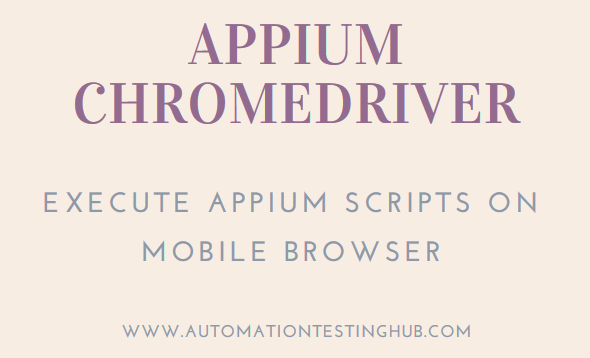Welcome to our mini-tutorial series on Appium Chromedriver. This is a series of three to four Appium Chromedriver articles that will help you execute your test scripts on Chrome broswer on a mobile device. The end goal of this tutorial would be to help you setup all the required tools and run a basic automation test script on Chrome browser on a mobile device.

A little bit of background
You would be aware that Appium is a great tool that helps you write automation tests for mobile apps. Another very good feature of Appium is that it lets you run test scripts on mobile browsers as well. If you already follow our Appium tutorial series and used it for automating mobile apps, then you would find it very easy to set it up for chrome browser as well.
Even if you are a beginner with Appium, you will see that its not very difficult to set it up. Appium setup for browser automation is relatively easier and needs fewer steps compared to mobile app automation. And this article will take you through all the steps that are needed to setup Appium for mobile browser automation.
Setup Appium for mobile browser automation
As mentioned above, Appium setup for mobile browser automation requires fewer steps compared to mobile app automation. If you are just starting with Appium, then please follow all the links given below carefully and perform all the steps exactly the same way as mentioned in the links. This will be helpful in getting the setup ready without much issues.
For those who have already setup Appium for mobile app automation using our Appium tutorial, please have a quick look at each of the links to make sure that you have completed all these steps.
Step 1: Java Installation and Setup
With Appium, we would use Java to write these automation scripts for mobile browser. The articles given below helps you correctly install Java and setup the environment variables.
Step 1.1: Download and Install latest version of Java (JDK)
Step 1.2: Setup Java Environment Variables
Step 2: Appium tool setup
Follow the articles given below to download Appium Desktop App and the JAR files that would be needed for mobile browser automation.
Step 2.1: Download and Install Appium Desktop App
Step 2.2: Download and Install Eclipse IDE for Java
Step 2.3: Turn On USB Debugging on your Android Device
Step 2.4: Download Appium Jars for Eclipse
Step 2.5: Create new project in Eclipse for Appium
Step 3: ChromeDriver setup
Next step is to download ChromeDriver. Like Selenium, Appium also interacts with Chrome browser by using Chromedriver. Because of this you would need to setup Chromedriver as well. As of now, follow the link given below and just download the ChromeDriver. Don’t worry much about the additional steps that show how you can use Chromedriver. We will cover that when we write our test script for mobile browser. So for now, just follow the article till section ‘Download Selenium ChromeDriver’ to download and retrieve chromedriver.exe from the zipped file.
Step 3.1: Download Chromedriver
With this, we complete our Appium Chromedriver setup article, where we have provided all the main links that will help you setup Appium for Chrome browser automation. If you have any issues with any step in the setup, then please feel free to write to us using the comments section.
Next Steps
Check out our Appium Tutorial series and scroll down near the end of the page to check out the remaining articles on mobile browser automation with Appium.